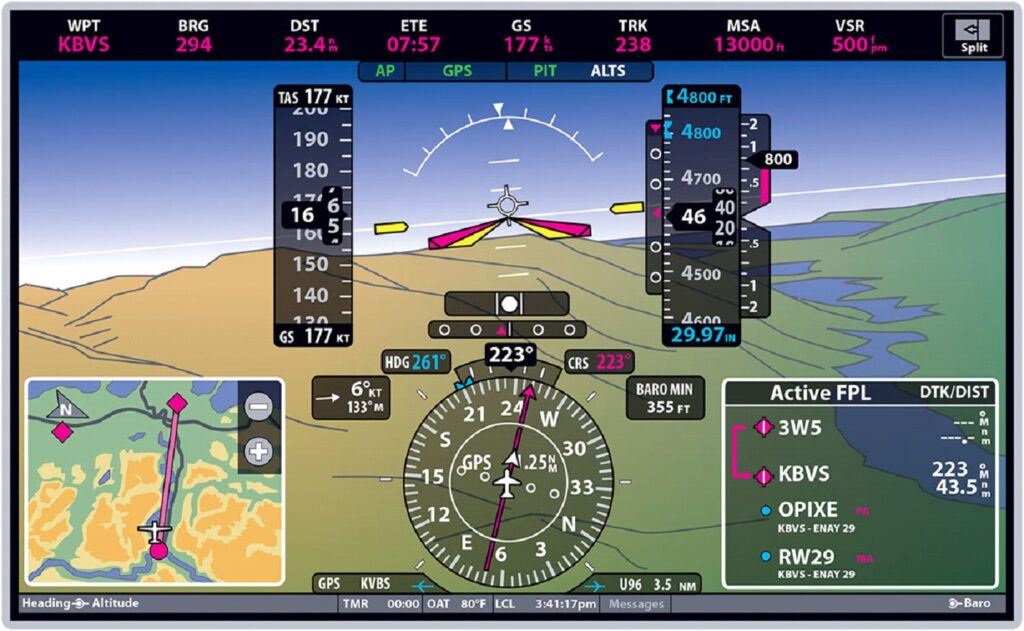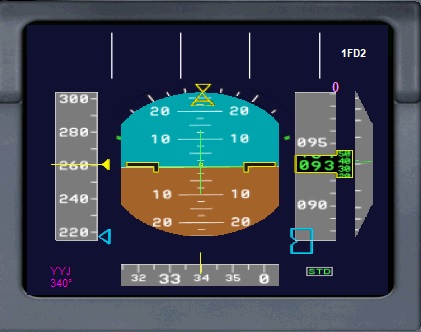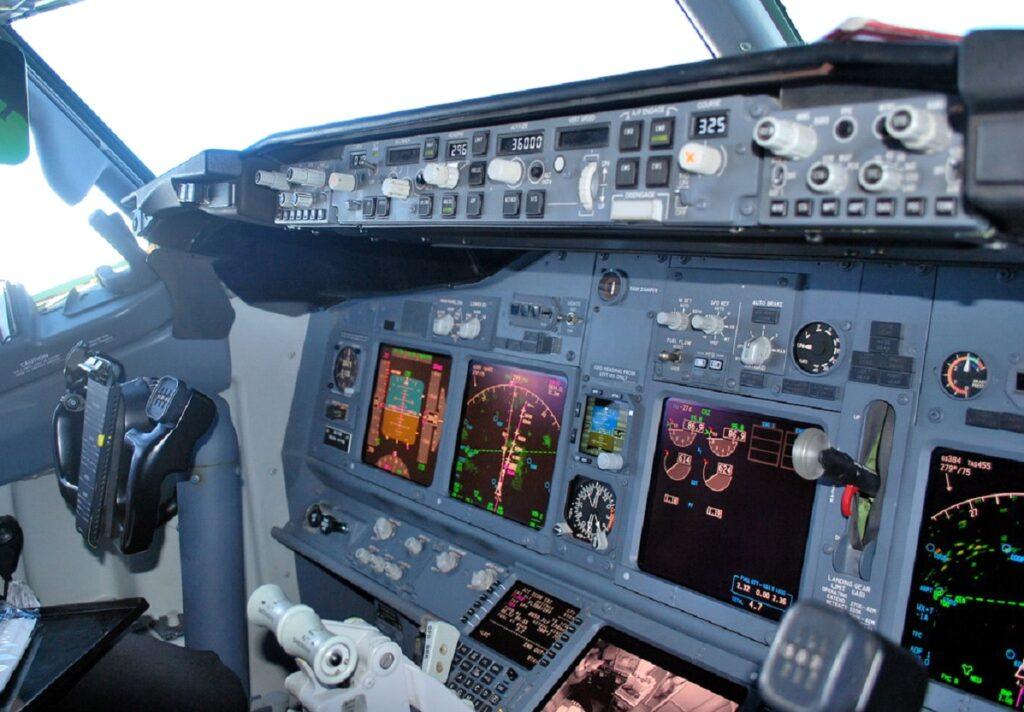Aircraft Primary Flight Display (PFD) – The Evolution of Flight Data Displays: Exploring Modern Aircraft Equipment:
A primary flight display, sometimes known as a PFD, is modern aircraft equipment that displays flight data. Primary flight displays, like multi-function displays, are based on a Liquid Crystal Display (LCD) or a CRT display technology. On a single compact display, representations of older six-pack or “steam gauge” instruments are combined, simplifying pilot operations and streamlining cockpit layouts.
Glass cockpits with primary flight and multi-function displays are standard on most airliners constructed since the 1980s and many business jets and an increasing number of modern general aviation aircraft (MFDs).
Let’s take a closer look at primary flight displays and see how they work.
The history of the primary flight display:
The first instrument displays were primitive analogues of the analogue instruments they replaced, often equipped with a simple red indicator. However, at this time, in-flight monitoring and aircraft performance was still handled by “equipment operators” or “buddy fliers”, and they needed instruments to aid their duties. These instruments included “crash gauges” (the sound of the impact of an aerodynamic component) and other types of analogue or digital instruments designed to monitor engine performance, airspeed, and pitch and aid pilot with aircraft performance and operations.
Why PFDs?
PFDs are powerful onboard electronics that provide pilots with aircraft information and flight conditions while displaying the data on large glass screens. PFDs provide critical information during flight to improve the pilot’s situational awareness and may benefit medical procedures during emergencies and other time-sensitive applications. PFDs are also required on aircraft operating in the U.S. commercial air, marine, and other non-military aviation sectors.
These devices have many functions, but a primary flight display (PFD) is a control display that allows flight crews to easily and rapidly find flight information, such as airspeed, altitude, altitude brakes, and whether they have the system selected to fly manually.
How PFDs work:

In the case of a proper PFD, the display is situated in the pilot’s eye-line. In the pilot’s view of the PFD, a liquid crystal display encased in glass plays back the selected navigation and weather information. As the pilot looks to either the left or right side of the glass, the display fills. The pilot’s eyes perceive two different views of the exact location on the glass display: that viewed directly in front of the pilot and viewed from a side angle.
The two views are used in conjunction to give the pilot simultaneous information on heading, altitude, angle of attack, airspeed, velocity and ground speed.
Typically, the video signals are generally displayed in the primary view and primary elevation position when the throttle is held to maintain straight and level flight.
Reading the primary flight display:

The flight director comprises horizontal and vertical lines. The former signifies the aircraft’s pitch, while the latter denotes the roll. During ascension, one needs to roll towards the left, and during descent, one needs to roll towards the right. The speed indicator or speed scale located on the left of the primary flight display shows the aircraft’s speed. The speed tape moves downwards as the speed increases and upward as it decreases, indicating acceleration and deceleration, respectively. The altitude and vertical speed indicator is located on the right of the primary flight display.
The altitude tape moves downward during ascension and upward during descent, while the vertical speed pointer indicates the rate of climb or descent in feet per minute. The heading indicator at the bottom display shows the current heading from 0 to 360 degrees, while the flight mode annunciator at the top of the PFD provides information about the autopilot, auto thrust, and navigation.
Both small and large aircraft are equipped with a primary flight display. Larger planes have two displays, while smaller ones have only one, but the functionality is the same. The Cessna model features a round dial altitude.
What’s the difference between a PFD and an MFD?
A significant difference between PFDs and the older six-pack display is that both are optional on modern commercial aircraft. Their displays are not directly interconnected to control loops or engine instruments.
An MFD is a non-glass cockpit instrument that provides information such as thrust and manifold pressure and aids the pilot in navigating the aircraft on instruments such as wind shear, airspeed, heading, and altitude.
A PFD is a glass cockpit instrument that includes instrument and control displays; it is not a separate electronic instrument. It is a primary flight display but not a primary flight instrument.
Advantages of PFDs over traditional systems:

PFDs use LCD technology instead of a large sheet of glass. Glass cockpits require the aircraft owner or pilot to pay for any damage done to the glass by the occupants. These machines are more expensive to build and operate than electronic displays, but the PFDs tend to last much longer than an LCD display, allowing an operator to save up to $5,000 per plane per year in maintenance and repair costs. In addition, PFDs are generally less obtrusive than large LCDs.
These features combine to make PFDs practical and cost-effective options for any aircraft type or size, although additional resources, such as windows for a separate display, are necessary for some aircraft types.
Before the 1930s, most aviation displays were installed on large illuminated dials.
Disadvantages of PFDs:
There are several ones, but we list a few ones here:
⦁ PFDs are often less reliable than the aircraft’s digital engine controls.
⦁ PFDs are more complicated to use and require more training to operate effectively.
⦁ PFDs are frequently misaligned (known as “feed drift”), which causes the instruments to be out of alignment.
⦁ PFDs are not as effective at gauging altitude because the altimeter is always given first, leaving a gap between the altimeter number and the display number. This gap makes it difficult for the pilot to determine the exact altitude.
⦁ PFDs must be calibrated annually to ensure that they display the correct airspeed and altitude (while working correctly).
⦁ PFDs cannot display weather instruments because of their smaller size, which means they are not widely available for navigation.
When Should a PFD Be Used?
In the cockpit of a general aviation aircraft, when it’s the only instrument available to the pilot, a primary flight display is the only option available. It is best used when the pilot is involved in a flight at very low altitudes and visibility. It may be used for engine failures in airplanes that require high-altitude, low-visibility landings. It is often used to position the airplane for landing if the autopilot fails and the engine will not operate on its own, and it can also be used to position the airplane on the ground in poor visibility or terrain in which you are not familiar with.
The reliability of PFDs can be improved by adding a CCD display or other backup instrumentation such as a pressure altimeter or CFC.
Flight Simulator primary flight displays:
Irrespective of the aircraft version in Flight Simulator, the primary display closely resembles the real aircraft. In smaller planes, the display is both sizable and clear, and in Boeing aircraft, it can be enlarged further by double-clicking.
Where the primary flight display get the information?
While connected to an air data computer, it is not directly linked to the sensor.
Conclusion:
Modern technology allows for a multi-function display in almost every cockpit to display the instruments necessary to run a flight. These instrument panels simplify the cockpit, saving time and effort, especially when a major operator or copilot is at the controls.
Because of the new technology and the extra information they provide, the instrumentation will focus on many companies advertising flight data displays in the coming years.
The other instrument panel manufacturers will most likely continue to produce the same old products but provide users with the latest and greatest instruments on the market.
What do you think about PFDs? Do you find them reliable, or do you still prefer the old ones? I would like to hear your thoughts, so feel free to share it in the comments below.


“The most common approach to flying a plane is using a control stick, also known as a yoke or joystick. A pilot uses this device to direct the plane’s movement, much like operating a car. The controls include the rudder, elevator, nose wheel steering (which allows you to turn the nose of your plane), flaps, landing gear, trim tab, and engine throttles. These controls allow pilots to maneuver the aircraft in any direction and change the plane’s pitch. Pilots use these controls to make changes in direction, climb and descend, bank left and right, and even adjust the amount of power put into each engine. The controls for most aircraft are located above the pilot’s seat.
I learned a lot from this article. Thank you for putting in the time.
Thank you for the feedback. Yes when it comes to aircraft there are a lot of controls you need to use. If you are using the Logitech joystick you can find throttle, buttons for trim, flaps, gear and view the aircraft using the hat switch on the top of the joystick.
The continental body agreed to follow up on the request that the three nations issued last week to become, in the future, members of the community bloc. As reported by the official Twitter account, the 27 current participants asked the Commission to start the procedure.
This Monday, March 7, the countries of the European Union resolved that the corresponding procedure will be initiated so that Ukraine, Moldova and Georgia can join the community club in the near future. This happens a week after the trinomial of countries made the request to Brussels.
Thank you for dealing with the PFDs advantages and disadvantages. I have always been concerned about how PFDs are frequently misaligned. In my book, that is the worst disadvantage. But I feel that the advantages outrank disadvantages by far!
Informative article on using primary flight displays for flight simulations. How realistic is it to learn to fly with a simulator? I imagine there must be quite a market for this since the cost of flight lessons is often prohibitive for many people. I’m just wondering how easy training on a simulator might translate into flying in the real world.
The primary flight display in flight simulator are found in real aircrafts. For those interested in flight simulator it will be easy to understand how primary flight display works.
Thanks for this excellent post. I am a pilot, although not so current at present and have ratings for Cessna 152, 172 and Piper 181. The planes I have flown have all just had traditional old-fashioned guages, rather than the nice PFD screen as seen in your picture. I have certainly used the PFD on MS Flight Simulator and they are a fantastic gadgit, rather than relying on multiple instruments to give you the data.
I found your comment in the disadvantages about the delays very interesting and I guess as a pilot it is just being aware of this slight lag.
The technology just seems to keep getting better – no longer just having to navigate by plotting with a pencil on a map but being able to cross-reference with GPS location. This is just another example of improvements that make flying easier and safer.
Thanks
Richard
Thanks for the comments. The aircraft primary display now is more advanced as technologies develops.